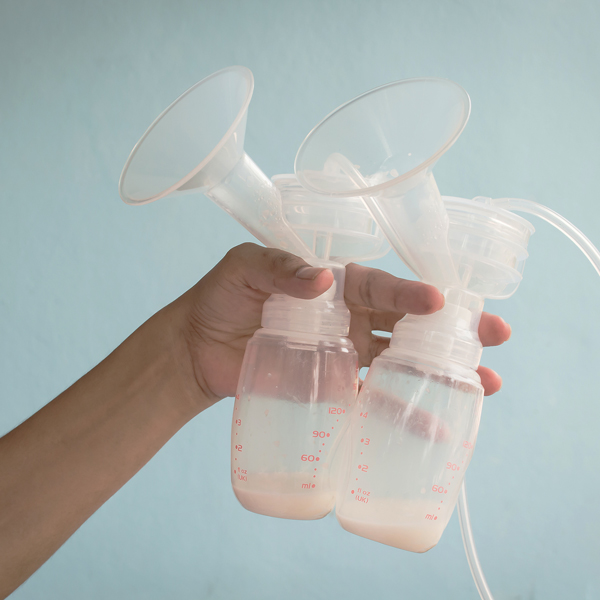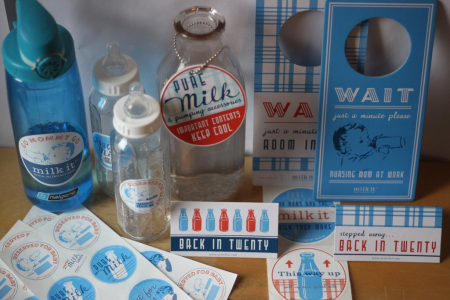Pumping at Work

Pumping at work kinda sucks, ladies, not gonna lie… but it’s sooooo worth it to be able to provide your babe with the good stuff when you can’t do it in person.
The goal here is to make it suck as little as possible. (Thanks to everyone on my Facebook page who contributed to this article – crowd-sourcing, baby!)
* This article assumes that you have the mechanisms in place to pump at work. For more on pumping-at-work rights and statistics, go here.
Equipment
Unfortunately, pumping at work is a bit equipment-intensive. Here is what veteran pumpers recommend for optimal efficiency:
Pumps
For heavy-duty pumpers, a high-quality pump will make a world of difference. It’s imperative that your pump has enough suction (to not diminish your supply) and speed (so you don’t get fired) – just kidding (sort of).
*The Affordable Care Act (a.k.a. Obamacare) requires health insurance providers to cover pumps, lactation consulting, and other related equipment at no cost. However, every plan is different in what they cover; get the lowdown here. Bottom line: call your insurance company to find out for sure.
Another tip: if you want a specific pump that isn’t listed on your insurance, call the company itself to see if they can work with you to help: 1) get you the product through a DME and 2) get you at least some/partial coverage.
Outside of a hospital-grade pump, check out our complete guide to our favorite breast pumps. Armed with one of these pumps, you’ll be well equipped for battle.

Here and There
While not feasible for everyone, multiple women suggested buying two pumps: one for the home and one for the office (if you’re working in-person, obviously) – especially if you’re in it for the long-haul. “This is one less thing you’ll have to carry back and forth each day, especially if you’re riding the subway or bus. I hate being loaded down like a pack-mule,” said one mom.
If you’re not pumping a lot at home, another recommendation is to keep your electric pump at the office and a manual one at home. Also, many moms suggested to keep a manual pump at work, too, in case your electric pump fails you (gah!).
A great manual pump is the Medela Harmony or the Philips Avent Manual Pump. [Now I’m having flashbacks on hiding in the supply closet at work with my manual pump because there were no outlets. HELLLLL! I think I got carpel tunnel (could I have gotten Worker’s Comp for that??). I digress…]

Breast Shield Flanges
There are a few different strategies for cleaning flanges. One mom suggested, “If you don’t want to bother washing your flanges at work each time, buy as many sets as the number of times you pump each day, then simply throw them all in the dishwasher when you get home each night.” Another common suggestion is to refrigerate (and reuse) your flanges in between pumping sessions instead of washing them at work. Still others recommend bringing some dish soap and washing them between each use. Your call.
Remember: Frequent pumping can make your nipples REALLY sore. Did you know there are five different flange sizes? It’s imperative to use the correct size flanges to fit you. Flanges that are too big won’t allow it to seal properly around your breast; flanges that are too small will cause excessive squeezing and irritation. I also recommend you smear Lansinoh (or some other lanolin-based cream) around the rim of the flange to decrease friction. It’s amazing what a difference a little lubrication can make!
Hands-free Pumping Bra
Most agreed that a hands-free pumping bra for pumping at work is imperative. The crowd-favorite is the Simple Wishes hands-free bra. One mom added, “I actually have two: one at home and one always in my work pump bag so I never risk forgetting it.”
Nursing Cover
Many suggested wearing a nursing cover while pumping, especially if you don’t have access to your own private space with a locking door. One mom said, “I can’t tell you how many people walk in while I’m pumping. Thank God for my nursing cover!”
Keeping it Cold
For getting your milk home every night – and especially if you don’t have a fridge at work, get a small cooler like the Ameda Cool ‘N Carry Milk Tote. Many pumps also come with an insulated bag with ice packs. Storing your milk in the cooler inside a shared refrigerator will also help with privacy concerns (“That’s not coffee creamer!”). (See more on breastmilk storage.)
A Sharpie
For labeling everything.
A Water Jug
For you. Because you can NEVER drink enough water while nursing. (May we suggest a Hydroflask?)
In the Car
For those who have to pump on the go, the car adapter is key; said one mom, “I’m in sales and I pump in my office, which is my car. Thank God for the car adapter!”
Logistics
A Real Let-Down
Getting your milk to let-down is one of the biggest challenges for moms pumping at work – the cold, sterile office environment isn’t exactly reminiscent of your soft, snuggly baby. You can record a clip of your baby crying [or cooing] in order to help out in this area.
Other suggestions include bringing a photo of your baby to look at and/or a piece of clothing that smells like your baby. One mom added, “I used to smell my baby’s lovey while I pumped. My daughter had one at home too and at the end of the day, we would trade and I would get hers and she would get mine; it helped me feel closer to her.”
Remember: You need to trick your body into thinking you have a hungry babe in your arms… not always easily done.
Pumping Schedule
If possible, try to mimic your feeding schedule at home. If you typically feed baby at 11 AM and 2 PM, for example, this is when you want to pump. If not, get as close to your regular times as possible. Try to schedule meetings outside of pumping times. The more you stick to your normal routine, the better.
No Pressure
Veteran pumpers agree that one of the hardest things is to not fret about how much milk they’re producing: “Try to just… zone out and relax as much as possible. Don’t focus on how much milk you are getting; once I see the milk flowing I don’t look again until my time is up. The more I am watching, the less I produce, it seems.” Another added, “Set a timer so you aren’t worried about how long you’ve been gone and when you need to get back. Look at pictures or videos of your baby, listen to music, whatever you need to do to relax and not think about pumping.” “Whatever you do, don’t work,” added another. Hey, I like that advice!
Many moms experienced a decrease in supply after going back to work; try not to stress about it. “Make pumping a priority or else your supply will dry up and you’ll feel defeated,” added one mom. To boost your supply, you may want to try a galactagogue (like Motherlove More Milk supplements), a tea (like Mother’s Milk), lactation cookies, or even oatmeal. One mom noted, “I find that compression and massage toward the end of the pump session seem to help me maximize my supply.”
“Do the best you can,” said one mom, “even if you’re only able to pump 10 minutes at a time, it’s better than skipping a session altogether, and it will really help maintain your supply.”
EAT
Sounds obvious, but with all the time being sucked up from pumping [gawd, I’m funny], it’s really hard to find time to eat and drink.
Remember: nursing moms are eating for two (sort of), so skimping on food and water will negatively affect your supply. Make a habit of bringing your snack and water jug with you to pump — you’ll need something to do anyway.
Privacy
Look, you can’t NOT feel ridiculous while hooked up to a machine like a dairy cow, but try to maintain a sense of humor about the whole thing. The beloved Milk It Kit includes cute door hanger privacy signs and “Be back in 20” signs.

“Don’t try to hide it or feel ashamed of pumping at work. I find that if I joke about it, it helps disarm my coworkers,” said one mom. Another suggested, “Don’t be all hostile about your right to pump, this will just make everyone mad. People will resent you because they think you’re getting all this extra ‘break time,’ so try to explain how important it is to you and just be nice.” Another said, “Men will automatically be uncomfortable about the thought of you pumping near them – take full advantage of this.” Ha!
Keep the Faith
“Set small goals for yourself, like… I just need to make it one more month or two more months, rather than thinking about how far away one year seems (depending on how long you want to aim for); with each milestone you reach, you will feel that much more accomplished and relaxed.”
In closing, a message from all my Facebook pumping moms to you:
“Feel proud that you are working and providing for your family; try to enjoy the time away from home when you can use your adult brain.”
It’s hard work, but you can do it!! Good luck!!!
Pumping Articles and Resources:
- The Milk Memos: How Real Moms Learned to Mix Business with Babies-and How You Can, Too
- Why I breastfeed, even if it totally sucks
- WorkAndPump.com
- Pumping from Kelly Mom
Thank you Lucie’s List. Just, thank you, for everything. I’m a first-time mom and am addicted to your humor, recommendations, and spot-on accuracy. You know what I’m thinking before I get my scheduled Crib Notes email, which is the only email subscription I eagerly await every week. I think your service is my spirit animal.
Amen ! I’m a nurse, but man, was I naive on this baby stuff! I feel so grateful for their info and their relatable approach! So glad a doctor friend of mine put me on to Lucie’s list.